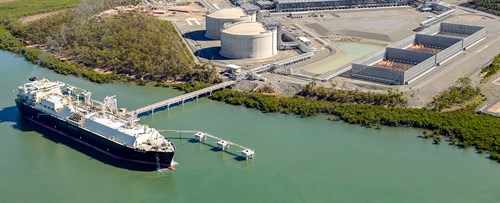State agency wants net zero carbon emissions from Australia's biggest LNG plant this decade
(Reuters) - A state agency in Australia has backed a plan to extend the life of the country's biggest liquefied natural gas plant by 50 years, so long as it achieves net zero carbon emissions for the rest of this decade, partly to protect ancient indigenous rock art.
Woodside Energy Group, the operator of the North West Shelf LNG plant, environmental groups and other interested parties have three weeks to lodge appeals against the recommendations made by the Western Australian Environmental Protection Authority (EPA).

After that the state's environmental minister will take a final decision on whether to approve an extension to the life of the plant, which is co-owned by Woodside, BP plc, Chevron Corp, Shell Plc, and a joint venture of Mitsubishi Corp and Mitsui & Co.
The environmental agency recommended that the plant must avoid, cut or offset all of the plant's carbon dioxide emissions out to 2029, and cut oxides of nitrogen (NOx) emissions in order to protect the rock art of the Murujuga indigenous people against industrial pollution.
"The EPA considers that there may be a threat of serious or irreversible damage to rock art from industrial air emissions ... accelerating the natural weathering," the agency said in its assessment of the life extension plan.
Woodside said it would carefully consider the conditions outlined by the EPA.
"At a time of heightened concern around energy security, the NWS Project has an important role to play in delivering natural gas to local and international customers, providing energy that can support their decarbonisation commitments," Woodside's Australian operations vice president Fiona Hick said in a statement.
Woodside, among other measures, has proposed to achieve net zero greenhouse gas emissions by 2050 by cutting emissions from the plant by 246 million tonnes of carbon dioxide-equivalent (Mt CO2-e). It would partially offset emissions by buying carbon credits, resulting in a net reduction of 138.85 Mt CO2-e.
The EPA said its recommended condition to 2029 would cut those emissions over the 50-year life from 138.85 Mt CO2-e to 128.2 Mt CO2-e.
Protecting the Murujuga rock art, which has been nominated for a UNESCO World Heritage listing, is a top priority in the wake of the destruction of ancient indigenous caves by Rio Tinto for an iron ore mine in Western Australia.
The EPA noted there have been conflicting scientific studies on whether industrial emissions on the Burrup Peninsula have damaged the rock art, and expects results from the state's own monitoring programme in 2023.
(Reporting by Sonali Paul; Editing by Simon Cameron-Moore)

- ExxonMobil halts 1-Bft3d blue hydrogen project in Texas
- Aramco and Yokogawa commission multiple autonomous control AI agents at Fadhili gas plant
- Ukraine will resume gas imports via Transbalkan route in November
- Mitsubishi to inject $260 MM into Brunei LNG project
- Freeport LNG (U.S.) on track to take in more natgas on Thursday after unit outage



Comments